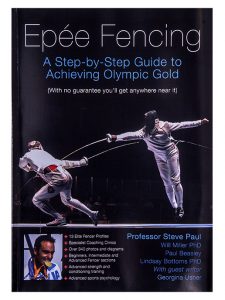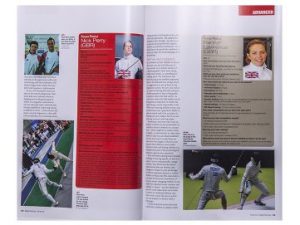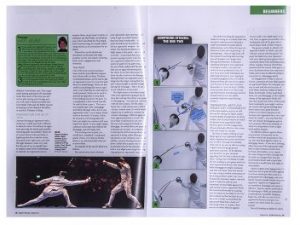We use cookies
Using our site means you agree to the use of cookies and similar technologies. Read about our policy and how to disable them here
"Fencing and books – two of my favourite things together in one picture". The comments to our Instagram celebration of world book day back in April suggest that we’re not the only ones to enjoy a good read from time to time. All the better, if it’s fencing-themed. So what could we do better than to share our finds and have the books available on our website reviewed by fencers, from international top athletes to fencers more like you and me? We start with a review by our Instagram girl and epee fencer Johanna (who definitely belongs into the latter category ;) ) .
"Need. Them. All." That was my reaction when I discovered the book section on the Leon Paul website. What can I say: I’ve been drawn to letters and pictures printed on paper since I was little (my mum always told me the very first word I ever said was ‘book’) and, as much as I enjoy the company of fictional characters, from Alice in Wonderland to Zorro, getting some theoretical background on my sports has always been part of my life as a diehard bookworm. I even have to admit that, eagerly searching for every bit of information about my new favourite hobby, I raided the sports section of my local library when I took up fencing. (In my defence: I was already in my twenties at the time, and at this age you probably enjoy working with theories and scientific studies a little bit more than a ten year old!)
Having asserted why I got carried away in front of all the new supply to my bibliophilia sold by Leon Paul, let’s get to the one book in particular I’d like to talk to you about: among all the manuals and biographies (including world class fencer and coach Sergei Golubitsky, whom one of the Leon Paul foil blades is named after) available, there was one publication I felt particularly attracted to, both due to its title and the attention-grabbing image of a jump-attack on its cover. “Epeefencing. A step-by-step-guide to achieving Olympic gold” sounded a tad too ambitious for me (after all, I was just another adult trying to learn fencing), but the addition “without any guarantee you’ll get anywhere near it” somehow seemed to suggest that it be an enjoyable read for the average (fencing) Joe after all.
As it turned out, my gut feeling was right, not only regarding the intended audience (more on that later), but also about the book being a great catch in general. (So, sometimes you just CAN judge a book by its cover ;) ). As a matter of fact, it has secured a fixed place both in my heart and my fencing bag (since it’s flexible and very light, weighing just over 500g, it’s the perfect after-practice read on the train home), and I am pretty sure that even if it had been available in my local library, I would have purchased it sooner or later, just to call it my own. Why? The short answer to this question is: because it’s a fencing book that differs from any other I’ve seen so far. And I dare say, between the aforementioned library and books pinched borrowed from my fencing coaches, I’ve seen a few, in various languages.

If you're in for the long version why this book is so different, stay with me now ;)
The first thing that is different about this book is the presentation: it comes across more as a magazine than a book. Many high quality photographs - not for nothing, Augusto Bizzi, who nowadays is the official eye of the FIE, is mentioned in the picture credits – on glossy paper almost give it the look and feel of a fashion monthly (I guess that’s the shoeaholic in me talking). The fact that it’s not a hardcover but an approximately DIN A4 shaped softback adds to that impression, as do the frequent coloured graphics and highlighted quotes and text parts.

Another feature I’ve not found in any of the numerous fencing books I’ve read so far is the clear distinction between different categories of fencers depending on their experience and abilities. Of course, you’ll find some sort of progression in most fencing books (there’s little point in explaining a combined attack if before you haven’t dealt with the basic elements it consists of), but the approach here is totally different, since this book is divided in 3 sections corresponding to three levels of fencing skills: Beginner (pp.8-39 ), Intermediate (pp. 43-85) and advanced (pp. 86-149). All the explanations, tips, tricks and advice – regarding technique, fitness, psychology and background information about fencing tournaments –are tailored to the specific needs of these three categories. Just to give one example: The quarte, sixte and octave parries are all treated in the technique pages of the beginner’s section, while you’ll have to wait until the chapters for intermediate fencers to get to know the prime parry.
This skillset-based approach is especially helpful for beginners and fencers who have just reached the intermediate level, since this means you won’t get overcharged with lots of concepts that will only be relevant for you later on. (And for the curious among us ;) : it’s not forbidden to peek into the chapters dedicated to ‘high class fencing’ , even if you have not yet reached the ‘advanced’ level).
A big part of what makes this book an ideal companion for any fencer, is the structure I mentioned earlier: thanks to the progressive approach, you’ll always find with relative ease the tips and instructions that are right for you and your specific level of fencing. The coloured graphics and text boxes (one of my personal favourites are the “Clinic!” text boxes listing common mistakes in fencing moves and how to avoid them). Lots of tables with sample plans for training, competition and nutrition provide helpful guidelines, which you can then tailor to your needs (the book even provides space for personal notes at the end). Index of user-friendly-ness on a scale from 0 to 10: 12 (and no, that’s not a typo ;)).

Another feature to highlight is the style the book is written in: the explanations are very clear and have just the right amount of detail, which makes it easy to grasp even complex moves and tactical decisions. Add some personal anecdotes and an ounce of British humour to that, and you have a fencing manual that is as enjoyable to read as it is useful. (I couldn’t help laughing out loud when reading some sentences, which got me some curious looks while reading it on a train!).
Definitely a must-read for every fencer and a great addition to your collection of fencing books (almost) no matter your age and skill level. Children aged 11 and under might get a bit overwhelmed by all the details regarding fencing technique and are probably better off with a more practical approach when it comes to learning the right moves... but the information about kit and tournament organisation can still prove useful both to the little fencers and their parents discovering the sport.

